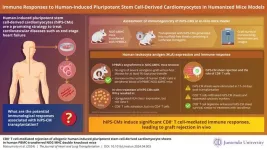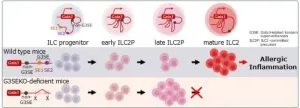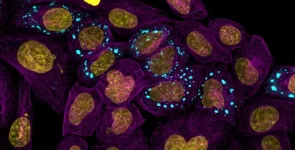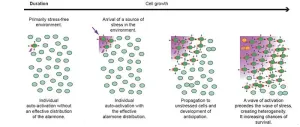(Press-News.org) A smartphone’s unique Bluetooth fingerprint could be used to track the device’s user–until now. A team of researchers have developed a simple firmware update that can completely hide the Bluetooth fingerprint, eliminating the vulnerability.
The method was developed by a team of researchers at the University of California San Diego. The team discovered the vulnerability caused by Bluetooth fingerprints in a study they presented at the 2022 IEEE Security & Privacy conference. They presented the fix to this vulnerability two years later at the 2024 IEEE Security & Privacy conference. The math behind the update itself is complex but the implementation is not.
“We assumed the strongest possible attack, a nation-state type of attacker that would know which algorithm we are using. They still failed,” said Aaron Schulman, one of the paper’s senior authors and a faculty member in the UC San Diego Department of Computer Science and Engineering.
Mobile devices, including phones, smartwatches and fitness trackers, constantly transmit signals, known as Bluetooth beacons, at the rate of roughly 500 beacons per minute. These beacons enable features like Apple’s “Find My”--a tracking service to find a lost device as well as COVID-19 tracing apps; and connect smartphones to other devices such as wireless earphones.
The current approach taken by smartphone companies to make the devices hard to track by their Bluetooth signals is to randomly change the phone’s identity, its MAC address. However, that doesn’t address the physical-layer fingerprints inherent in each device’s transmissions due to unique hardware imperfections.
All wireless devices have small manufacturing imperfections in the hardware used to emit these beacons that are unique to each device. These fingerprints are an accidental byproduct of the manufacturing process. These imperfections in Bluetooth hardware result in unique distortions, which can be used as a fingerprint to track a specific device.
The method the researchers developed uses several layers of randomization. The nature of the method is complex, but it’s a bit like using several layers of contact lenses to mask a person’s original eye color–and switching those layers repeatedly and randomly. This method would make it difficult to infer the person’s true eye color–regardless of what the original color actually was.
The UC San Diego researchers implemented a prototype of this new defense on the Texas Instruments CC2640 chipset currently used in a number of smart devices, such as fitness trackers, tags and lighting systems. They analyzed the impact of different parameters that affect the success of attacks to track and fingerprint a device in practical scenarios. The result of their tests shows that the adversary has to observe a device continuously for more than 10 days to achieve the same level of tracking accuracy as they could achieve within a minute without the firmware update.
“This means that the fingerprints are no longer useful for the attacker to infer the identity of the device and the optimal attacker can barely do better than a random guess,” said Professor Dinesh Bharadia, one of the paper’s senior authors and a faculty member in the UC San Diego Department of Electrical and Computer Engineering.
“You can’t track the phone’s fingerprint even if you’re sitting right next to it, because both MAC and PHY identities keep changing,” he added.
Researchers are now looking for industry partners that can build this technology into their chipsets.
“This defense can be rolled out incrementally, requiring only software modification on at least one widely-used Bluetooth Low Energy chipset,” said Hadi Givehchian, the paper’s first author and a Ph.D. student in the UC San Diego Department of Computer Science and Engineering. “But in order to deploy this defense widely, we need to partner with Bluetooth chip manufacturers.”
The team also believes that the method would work to obfuscate WiFi fingerprints.
Practical Obfuscation of BLE Physical-Layer Fingerprints on Mobile Devices
University of California San Diego:
Hadi Givehchian, Nishant Bhaskar, Alexander Redding, Aaron Schulman, Department of Computer Science and Engineering
Han Zhao, Dinesh Bharadia, Department of Electrical and Computer Engineering
END
A simple firmware update completely hides a device’s Bluetooth fingerprint
The method is a fix to a vulnerability discovered by the same UC San Diego research team
2024-07-10
ELSE PRESS RELEASES FROM THIS DATE:
Immunogenicity of human-induced pluripotent stem cell-derived cardiomyocyte sheets
2024-07-10
Ischemic heart disease stands as a significant global cause of morbidity and mortality. One promising avenue for treatment involves human induced pluripotent stem cell-derived cardiomyocytes (hiPS-CMs). Derived from adult somatic cells such as blood or skin cells, hiPS cells possess the capacity to differentiate into various tissues, including cardiomyocytes. These cells can potentially repair damaged heart tissue, but their clinical application is limited due to concerns about immune rejection. Understanding the immunogenicity of hiPS-CMs is crucial for advancing their ...
Unravelling a mechanism of Group 2 innate lymphoid immune cell development
2024-07-10
Overproduction of Group 2 innate lymphoid cells or ILC2s—a type of white blood cells—can sometimes exacerbate conditions such as bronchial asthma, chronic rhinosinusitis, atopic dermatitis, and organ fibrosis through an exaggerated immune response. Although there are immunomodulatory drugs that can suppress Type 2 helper T (Th2) cells, drugs capable of suppressing ILC2s are currently lacking.
Now, however, in a breakthrough study that could lead to the development of a new therapeutic strategy targeting ILC2s, researchers led by Associate Professor Arifumi Iwata of the Chiba University Hospital, Japan, have identified molecular ...
Award for Excellence in Natural Product Chemistry to Ricardo Riguera
2024-07-10
The Specialised Group on Chemistry of Natural Products (GQPN) of the Spanish Royal Society of Chemistry (RSEQ) has awarded its Excellence in Research Award 2023 to Professor Ricardo Riguera. The Evaluation Committee thus recognises his valuable contribution to this area of chemistry. Among other advances, his work has made it possible to describe a large number of bioactive metabolites, such as the first heptacyclopeptide and the first cyclodepsipeptide isolated from marine organisms. Riguera also identified one of the first examples of cytotoxic metabolites from marine bacteria, the first description of L-galactose as part of a natural product, and the first description ...
Researchers develop an AI model that predicts Continuous Renal Replacement Therapy survival
2024-07-10
FINDINGS
A UCLA-led team has developed a machine-learning model that can predict with a high degree of accuracy the short-term survival of dialysis patients on Continuous Renal Replacement Therapy (CRRT).
BACKGROUND
CRRT is a therapy used for very sick hospitalized patients whose health status makes them ineligible for regular hemodialysis. It is a gentler therapy that provides continuous treatment over a prolonged period. About half of adults placed on CRRT, however, do not survive, rendering the treatment futile for both patients ...
Living in poverty due to mental health problems or developing mental health problems because of poverty? It's both.
2024-07-10
Poverty and mental illness are not only linked, but there is also a causal relationship. This is the conclusion of researchers from Amsterdam UMC, the University of Edinburgh and the University of Modena. Their study shows that while certain mental health issues can hinder financial stability, poverty is also one of the causal factors leading to mental health problems. This study was published today in Nature Human Behaviour.
"This study indicates that certain mental health problems can make a person's financial situation uncertain. But conversely, we also see that poverty can lead to mental health problems," ...
Atlas of proteins reveals inner workings of cells
2024-07-10
Scientists at the University of Cambridge have developed an atlas of proteins describing how they behave inside human cells. This tool could be used to search for the origins of diseases which are related to proteins misbehaving such as dementia and many cancers.
The atlas, which is published in Nature Communications, has allowed the researchers to find new proteins inside cells that are responsible for a range of important bodily functions. The team focuses on a droplet-like part of the cell called a condensate ...
Discovery of a new defense mechanism in bacteria
2024-07-10
When confronted with an antibiotic, toxic substance, or other source of considerable stress, bacteria are able to activate a defence mechanism using cell-to-cell communication to ‘warn’ unaffected bacteria, which can then anticipate, shield themselves and spread the warning signal. This mechanism1 has just been described for the first time by a team of scientists2 from CNRS and Université de Toulouse III – Paul Sabatier. It paves the way for the development of new, more effective antibiotic treatments that can target this bacterial communication system.
When they perceive a source of stress, bacteria spring into action, inducing changes in the expression of certain ...
Mozambican Woodlands could store more than double the carbon previously estimated
2024-07-10
The capacity of Mozambican woodlands to capture and store carbon is underestimated and potentially undervalued for their protection and restoration, finds new research from an international team of scientists including UCL researchers and led by carbon data provider Sylvera.
The research, published in Nature Communications Earth & Environment, found that miombo woodlands, which span large areas of Sub-Saharan Africa, store 1.5 to 2.2 times more carbon than had previously been estimated by standard methods.
Named for the miombo trees found in the region, these biomes (geographical areas defined by their local species and ...
Cutting farm nitrous oxide emissions helps climate and ozone layer
2024-07-10
Cutting farm nitrous oxide emissions helps climate and ozone layer
Adding crushed basalt rocks and special fertilisers can reduce potent nitrous oxide (N2O) greenhouse gas emissions and safeguard the stratospheric ozone layer, which protects us from harmful UV light and reduces nitrate leaching into water bodies protecting ecosystems and human health
The new study, led by researchers at the University of Sheffield, highlights methods for reducing N2O emissions, such as enhanced weathering of agricultural soils with ...
Blood cancer drug could make radiotherapy on brain tumours more effective
2024-07-10
Drugs developed to fight blood and other cancers could also help improve the efficiency of radiotherapy in the most commonly diagnosed low-grade brain tumour in adults, a new study has found.
Meningioma account for approximately 36% of all primary brain tumours. The majority are successfully treated by surgery, but some which can’t easily be accessed need to be treated with radiotherapy. That can cause significant side effects and radiation damage to the brain, while resistance to radiotherapy can also result in tumour growth.
A new study by researchers at the Brain Tumour Research ...
LAST 30 PRESS RELEASES:
First Editorial of 2026: Resisting AI slop
Joint ground- and space-based observations reveal Saturn-mass rogue planet
Inheritable genetic variant offers protection against blood cancer risk and progression
Pigs settled Pacific islands alongside early human voyagers
A Coral reef’s daily pulse reshapes microbes in surrounding waters
EAST Tokamak experiments exceed plasma density limit, offering new approach to fusion ignition
Groundbreaking discovery reveals Africa’s oldest cremation pyre and complex ritual practices
First breathing ‘lung-on-chip’ developed using genetically identical cells
How people moved pigs across the Pacific
Interaction of climate change and human activity and its impact on plant diversity in Qinghai-Tibet plateau
From addressing uncertainty to national strategy: an interpretation of Professor Lim Siong Guan’s views
Clinical trials on AI language model use in digestive healthcare
Scientists improve robotic visual–inertial trajectory localization accuracy using cross-modal interaction and selection techniques
Correlation between cancer cachexia and immune-related adverse events in HCC
Human adipose tissue: a new source for functional organoids
Metro lines double as freight highways during off-peak hours, Beijing study shows
Biomedical functions and applications of nanomaterials in tumor diagnosis and treatment: perspectives from ophthalmic oncology
3D imaging unveils how passivation improves perovskite solar cell performance
Enriching framework Al sites in 8-membered rings of Cu-SSZ-39 zeolite to enhance low-temperature ammonia selective catalytic reduction performance
AI-powered RNA drug development: a new frontier in therapeutics
Decoupling the HOR enhancement on PtRu: Dynamically matching interfacial water to reaction coordinates
Sulfur isn’t poisonous when it synergistically acts with phosphine in olefins hydroformylation
URI researchers uncover molecular mechanisms behind speciation in corals
Chitin based carbon aerogel offers a cleaner way to store thermal energy
Tracing hidden sources of nitrate pollution in rapidly changing rural urban landscapes
Viruses on plastic pollution may quietly accelerate the spread of antibiotic resistance
Three UH Rainbow Babies & Children’s faculty elected to prestigious American Pediatric Society
Tunnel resilience models unveiled to aid post-earthquake recovery
Satellite communication systems: the future of 5G/6G connectivity
Space computing power networks: a new frontier for satellite technologies
[Press-News.org] A simple firmware update completely hides a device’s Bluetooth fingerprintThe method is a fix to a vulnerability discovered by the same UC San Diego research team





